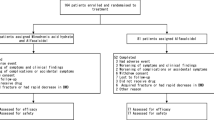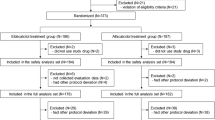Abstract
Supplementation therapy with plain vitamin D plus calcium is in general regarded as effective prevention or first-step treatment of glucocorticoid-induced osteoporosis (GIOP). The aim of our study was to compare the therapeutic efficacy of the D-hormone analog alfacalcidol with plain vitamin D in patients with established GIOP with or without vertebral fractures. Patients on long-term glucocorticoid (GC) therapy were included as matched pairs to receive randomly either 1 μg alfacalcidol plus 500 mg calcium per day (group A, n=103) or 1,000 IU vitamin D3 plus 500 mg calcium (group B, n=101). The two groups were well matched in terms of mean age, sex ratio, mean height and weight, daily dosage, and duration of GC therapy, and the percentages of the three underlying diseases included chronic obstructive pulmonary disease, rheumatoid arthritis, and polymyalgia rheumatica. The baseline mean bone mineral density (BMD) values at the lumbar spine for the two groups were −3.26 (alfacalcidol) and −3.25 (vitamin D3) and, at the femoral neck, −2.81 and −2.84, respectively (T scores). Rates of prevalent vertebral and nonvertebral fractures did not differ between groups. During the 3-year study, we observed a median percentage increase of BMD at the lumbar spine of 2.4% in group A and a loss of 0.8% in group B (P<0.0001). There also was a larger median increase at the femoral neck in group A (1.2%) than in group B (0.8%) (P<0.006). The 3-year rates of patients with at least one new vertebral fracture were 9.7% among those assigned to the alfacalcidol group and 24.8% in the vitamin D group (risk reduction 0.61, 95% CI 0.24–0.81, P=0.005). The 3-year rates of patients with at least one new nonvertebral fracture were 15% in the alfacalcidol group and 25% in the vitamin D group (risk reduction 0.41, 95% CI 0.06–0.68, P=0.081). The 3-year rates of patients with at least one new fracture of any kind were 19.4% among those treated with alfacalcidol and 40.65% with vitamin D (risk reduction 0.52, 95% CI 0.25–0.71, P=0.001). In accordance with the observed fracture rates, the alfacalcidol group showed a substantially larger decrease in back pain than the plain vitamin D group (P<0.0001). Generally, side effects in both groups were mild, and only three patients in the alfacalcidol group and two in the vitamin D group had moderate hypercalcemia. We conclude that alfacalcidol plus calcium is highly superior to plain vitamin D3 plus calcium in the treatment of established GIOP.





Similar content being viewed by others
Notes
Alpha D3 produced by TEVA. Brand names in Germany: Bondiol, Doss
References
Schacht E (1999) Rationale for treatment of involutional osteoporosis in women and for prevention and treatment of corticosteroid-induced osteoporosis with alfacalcidol. Calcif Tissue Int 65:317–327
Cantorna MT, Hayes CE, DeLuca HF (1998) 1,25-Dihydroxycholecalciferol inhibits the progression of arthritis in murine models of human arthritis. J Nutr 128:68–72
DeLuca HF, Cantorna MT (2001) Vitamin D: its role and uses in immunology. FASEB J 15:2579–2585
Andjelkovic Z, Vojinovic J, Pejnovic N, Popovic M, Dujic A, Mitrovic D, Pavlica L, Stefanovic D (1999) Disease modifying and immunomodulatory effects of high dose 1α(OH) D3 in rheumatoid arthritis patients. Clin Exp Rheumatol 17:453–456
Hein G, Oelzner P (2000) Vitamin D-Metabolite bei rheumatoider Arthritis: Befunde–Hypothesen–Konsequenzen. Z Rheumatol 59 [Suppl 1]:I/28–I/32
Scharla SH, Schacht E, Bawey S, Kamilli I, Holle D, Lempert UG (2003) Pleiotropic effects of 1α-hydroxyvitamin D (alfacalcidol) in patients with rheumatoid arthritis. Bone [submitted]
Van Cleemput J, Daenen W, Geusens P, Dequeker J, van de Werf F, Vanhaecke J (1996) Prevention of bone loss in cardiac transplant recipients. Transplantation 61:1495–1499
Reginster JY, Kuntz D, Verdickt W, Wouters M, Guillevin L, Menkès CJ, Nielsen K (1999) Prophylactic use of alfacalcidol in corticosteroid-induced osteoporosis. Osteoporos Int 9:75–81
Lakatos P, Nagy Z, Kiss L, Horvath C, Takacs I, Foldes J, Speer G, Bossanyi A (2000) Prevention of corticosteroid-induced osteoporosis by alfacalcidol. Z Rheumatol 59 [Suppl 1]:I 48–52
Sambrook PN, Birmingham J, Kelly PJ, Kempler S, Pocock NA, Eisman JA (1993) Prevention of corticosteroid osteoporosis: a comparison of calcium, calcitriol and calcitonin. N Engl J Med 328:1747–1752
Sambrook PN, Henderson NK, Keogh A, Macdonald P, Glanville A, Spratt P, Bergin P, Ebeling P, Eisman J (2000) Effect of calcitriol on bone loss after cardiac or lung transplantation. J Bone Miner Res 15:1818–1824
Adachi JD, Bensen WG, Bianchi F, Cividino A, Pillersdorf S, Sebaldt RJ, Tugwell P, Gordon M, Steele M, Webber C, Goldsmith CH (1996) Vitamin D and calcium in the prevention of corticosteroid induced osteoporosis: A 3 year follow up. J Rheumatol 23:995–1000
Buckley LM, Leib ES, Cartularo KS, Vacek PM, Cooper SM (1996) Calcium and vitamin D3 supplementation prevents bone loss in the spine secondary to low-dose corticosteroids in patients with rheumatoid arthritis. Ann Intern Med 125:961–968
Lau WK-H, Baylink DJ (2001) Treatment of 1,25(OH)2D3 (D-hormone) deficiency/resistance with D-hormone and analogs. Osteologie 10:28–39
Shane E, Addesso V, Namerow P, Maybaum S, Staron R, Lo S, Zucker M, Pardi S, Mancini D (2002) Prevention of bone loss after cardiac transplantation with alendronate or calcitriol: efficacy and safety. J Bone Miner Res 17:S135
American College of Rheumatology Ad Hoc Committee on Glucocorticoid-Induced Osteoporosis (2001) Recommendations for the prevention and treatment of glucocorticoid-induced osteoporosis. Arthritis Rheum 44:1496–1503
Richy F, Reginster JY (2002) Efficacy of D-hormones in primary and corticosteroid-induced osteoporosis: a meta-analysis of their effects on bone mineral density and fracture rate. Osteoporos Int [Suppl 3]:S21
Orimo H, Shiraki M, Hayashi Y, Hoshino T, Onaya T, Miyazaki S, Kurosawa H, Nakamura T, Ogawa N (1994) Effects of 1α-hydroxyvitamin D3 on lumbar bone mineral density and vertebral fractures in patients with postmenopausal osteoporosis. Calcif Tissue Int 54:370–376
Hayashi Y, Fujita T, Inoue T (1992) Decrease of vertebral fracture in osteoporotics by administration of 1α-hydroxy-vitamin D3. J Bone Miner Metab 10:50–54
Tilyard MW, Spears GF, Thomson J, Dovey S (1992) Treatment of postmenopausal osteoporosis with calcitriol or calcium. N Engl J Med 326:357–362
Gallagher JC, Fowler SE, Detter JR, Sherman SS (2001) Combination treatment with estrogen and calcitriol in the prevention of age-related bone loss. J Clin Endocrinol Metab 86:3618–3628
Boland R (1986) Role of vitamin D in skeletal muscle function. Endocr Rev 7:434–448
Ebert-Dümig R, Jovanovic M, Köhrle J, Jakob F (2001) Human 25(OH) vitamin D3-1α-hydroxylase promoter is regulated by TNFα-in HepG2 and HEK-293 cell lines. Exp Clin Endocrinol Diabetes 109 [Suppl 1]:S26
Oelzner P, Muller A, Deschner F, Huller M, Abendroth K, Hein G, Stein G (1998) Relationship between disease activity and serum levels of vitamin D metabolites and PTH in rheumatoid arthritis. Calcif Tissue Int 62:193–198
Haug CJ, Aukrust P, Haug E, Morkrid L, Muller F, Froland SS (1998) Severe deficiency of 1,25-dihydroxyvitamin D3 in human immunodeficiency virus infection: association with immunological hyperactivity and only minor changes in calcium homeostasis. J Clin Endocrinol Metab 83:3832–3838
Lempert UG, Minne HW, Albrecht B, Scharla SH, Matthes F, Ziegler R (1989) 1,25-dihydroxy-vitamin D3 prevents the decrease of bone mineral appositional rate in rats with inflammation-mediated osteopenia (IMO). Bone Miner 7:149–158
Shiraishi A, Higashi S, Ohkawa H, Kubodera N, Hirasawa T, Ezawa I, Ikeda K, Ogata E (1999) The advantage of alfacalcidol over vitamin D in the treatment of osteoporosis. Calcif Tissue Int 65:311–316
Saag KG for the Glucocorticoid-Induced Osteoporosis Intervention Study Group (1998) Alendronate for the prevention and treatment of glucocorticoid-induced osteoporosis. N Engl J Med 339:292–299
Cohen S, Levy RM, Keller M, Boling E, Emkey R, Greenwald M, Zizic T, Wallach S, Sewell K, Lukert B, Achselrod D, Chines A (1999) Risedronate therapy prevents corticosteroid-induced bone loss—a twelve-month, multicenter, randomized, double-blind, placebo-controlled, parallel-group study. Arthritis Rheum 42:2309–2318
Sarkar S, Mitlak BH, Wong M, Stock IL, Black DM, Harper KD (2002) Relationships between bone mineral density and incident vertebral fracture risk with raloxifen therapy. J Bone Miner Res 17:1–10
Ito M, Azuma Y, Takagi H, Komoriya K, Ohta T, Kawaguchi H (2002) Curative effect of combined treatment with alendronate and 1α-hydroxyvitamin D3 on bone loss by ovariectomy in aged rats. Jpn J Pharmacol 89:255–266
Erben RG, Mosekilde L, Thomsen JS, Weber K, Stahr K, Leyshon A, Smith SY, Phipps R (2002) Prevention of bone loss in ovariectomized rats by combined treatment with risedronate and 1α,25-dihydroxyvitamin D3. J Bone Miner Res 17:1498–1511
Wei LJ, Lachin JM (1984) Two-sample asymptotically distribution-free tests for incomplete multivariate observations. J Am Stat Assoc 79:653–661
Thall PF, Lachin JM (1988) Analysis of recurrent events: nonparametric methods for random interval count data. J Am Stat Assoc 83:339–347
Lachin JM (1992) Some large-sample distribution-free estimators and tests for multivariate partially incomplete data from two populations. Stat Med 11:1151–1170
Colditz, GA, Miller JN, Mosteller F (1988) Measuring gain in the evaluation of medical technology: the probability of a better outcome. J Technol Assessment Health Care 4:637–642
Author information
Authors and Affiliations
Corresponding author
Rights and permissions
About this article
Cite this article
Ringe, J.D., Dorst, A., Faber, H. et al. Superiority of alfacalcidol over plain vitamin D in the treatment of glucocorticoid-induced osteoporosis. Rheumatol Int 24, 63–70 (2004). https://doi.org/10.1007/s00296-003-0361-9
Received:
Accepted:
Published:
Issue Date:
DOI: https://doi.org/10.1007/s00296-003-0361-9




